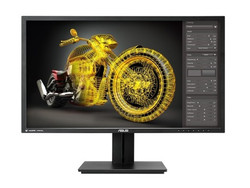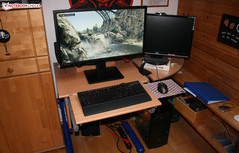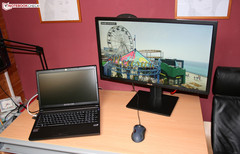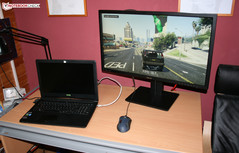Gaming in 4K
For the original German article, see here.
If you want to run games at 3840x2160 pixels, you will need an appropriate display. A little while back, the price difference between such high resolution notebooks and FHD notebooks was quite high, but nowadays the gap has become smaller. External displays, like the Asus PB287Q, are trending towards 4K.
For the user to enjoy the games at a resolution of 3840x2160 pixels, every part of the package has to be right: a fluid 4K experience at 60 Hz is only possible if the entire hardware runs on HDMI 2.0 or DisplayPort 1.2. We do not recommend 30 Hz as the cursor stutters a lot and a few games do not run well (ego shooter, etc.).
The scaling is another problem. Unlike Windows 8.1, which at least makes an effort to scale the menus, Windows 7 is not suited for the resolution of 3840x2160 pixels as many elements, despite lots of tuning in the options menu, are far too small. 4K does not run perfectly on any OS at the moment but we hope the experience will be vastly improved with Microsoft Windows 10. Problem no. 3 is the high performance requirements: even high-end desktop chips are pushed to their limits with 4K.
We used three powerful Nvidia notebook GPUs to feel out the performance at 4k. The GeForce GTX 980M and the GeForce GTX 970M are the top of their class whereas the GeForce GTX 960M belongs to the mid-tier. Cheaper models, like the GeForce GTX 950M, provide a weak 4k performance. Office-, all-round- and multimedia-notebooks are not designed for gaming at 4k. We rounded off the hardware with the most powerful desktop hardware. The GeForce GTX 980 is far more powerful than its notebook counterpart and the AMD Radeon R9 290X ranks a little behind.
| System | Desktop-PC Nvidia | Desktop-PC AMD | Schenker W504 | Schenker W504 | Schenker A505 |
|---|---|---|---|---|---|
| Graphics Card | Nvidia GeForce GTX 980 (4 GB GDDR5) | AMD Radeon R9 290X (4 GB GDDR5) | Nvidia GeForce GTX 980M (8 GB GDDR5) | Nvidia GeForce GTX 970M (6 GB GDDR5) | Nvidia GeForce GTX 960M (2 GB GDDR5) |
| Processor | Intel Core i7-3770K | Intel Core i7-4790K | Intel Core i7-4700MQ | Intel Core i7-4700MQ | Intel Core i7-4720HQ |
| RAM | 2x 4 GB DDR3-RAM (1,333 MHz) | 2x 4 GB DDR3-RAM (1,333 MHz) | 2x 4 GB DDR3-RAM (1,600 MHz) | 2x 4 GB DDR3-RAM (1,600 MHz) | 2x 4 GB DDR3-RAM (1,600 MHz) |
| OS | Windows 7 Prof. 64 Bit | Windows 8.1 64 Bit | Windows 7 Prof. 64 Bit | Windows 7 Prof. 64 Bit | Windows 8.1 64 Bit |
Each test system runs 8 GB DDR3 RAM and an Intel quad-core CPU (Core i7-4700MQ @Schenker W504, Core i7-4720HQ @Schenker A505 & Core i7-3770K @Desktop-PC). The rest of the hardware is detailed in the table above. Hint: as there are multiple versions for notebook GPUs (think VRAM), our results will not be identical to those of graphics cards from other manufacturers. The GTX 980M is available with 4 instead of 8 GB and the GTX 970M can be found with 3 instead of 6 GB. The GeForce GTX 960M can have either 2 or 4 GB. We used the latest ForceWare 350.12 as the graphics driver. This has been released by Nvidia especially for GTA V. We use the 15.4 Beta driver for the AMD GPU (also released for GTA V).
Benchmarks
Fire Strike Ultra
Let us get into the most important aspect of this review: the benchmarks. First off, the four high-end GPUs need to pass the testing grounds of the brand-new Ultra setting of the Fire Strike test (3DMark 2013). The GeForce GTX 980 can surpass its notebook version with a score of 3,026 points (+35%). The latter scores high at 2,243 points, which places it in front of the GTX 970M (1,643 points, +37%) and the GTX 960M (766 points, +200%). This is quite surprising as the Nvidia top dog manages to secure a mere 20% lead in front of the GTX 970M at the FHD resolution of 1920x1080 pixels. The Ultra test did not run flawlessly on any system. In fact, in most cases, the performance did not rise above 10-20 fps.
| 3DMark | |
| 3840x2160 Fire Strike Ultra Score (sort by value) | |
| GeForce GTX 980, 3770K | |
| Radeon R9 290X, 4790K | |
| GeForce GTX 980M, 4700MQ | |
| GeForce GTX 970M, 4700MQ | |
| GeForce GTX 960M, 4720HQ | |
| 3840x2160 Fire Strike Ultra Graphics (sort by value) | |
| GeForce GTX 980, 3770K | |
| Radeon R9 290X, 4790K | |
| GeForce GTX 980M, 4700MQ | |
| GeForce GTX 970M, 4700MQ | |
| GeForce GTX 960M, 4720HQ | |
| 3840x2160 Fire Strike Ultra Combined (sort by value) | |
| GeForce GTX 980, 3770K | |
| Radeon R9 290X, 4790K | |
| GeForce GTX 980M, 4700MQ | |
| GeForce GTX 970M, 4700MQ | |
| GeForce GTX 960M, 4720HQ | |
GTA V
The PC version of GTA V paints a better picture. Thanks to an average frame rate of 41.4 fps, the GeForce GTX 980M can handle the high details, FXAA and 8x texture filtering. We did not use the performance-hungry MSAA setting in this review. Owners of a GeForce GTX 970M will suffer a little: a resolution of 3840x2160 pixels and high settings result in an average of 32.4 fps (-22%). The GeForce GTX 960M is even worse off at 20 fps (-51% vs. GTX 980M). Of course, the notebook GPUs cannot even hope to compete with their desktop counterparts. The average of 59.4 fps is satisfying on the GTX 980 and ensures it a +40% edge over its mobile sibling. We tested the three games at FHD with identical settings and, as is to be expected, the gaps are far smaller.
- GTX 980: 93.8 fps
- GTX 980M: 86.9 fps
- GTX 970M: 80.6 fps
- GTX 960M: 61.2 fps
| GTA V - 3840x2160 High/On (Advanced Graphics Off) AA:FX AF:8x (sort by value) | |
| GeForce GTX 980, 3770K | |
| Radeon R9 290X, 4790K | |
| GeForce GTX 980M, 4700MQ | |
| GeForce GTX 970M, 4700MQ | |
| GeForce GTX 960M, 4720HQ | |
FIFA 15
FIFA 15 demands little from our GPUs as is readily apparent from the results. The GeForce GTX 960M is strong enough to run the football simulation game above 60 fps with max details. Its stronger siblings ensure an even better performance: +30% with the GTX 970M (82.2 fps) and +65% with the GTX 980M (104.4 fps). The desktop GPU takes the crown at 167.9 fps (+166% vs. GTX 960M). Once again we tested the FHD performance:
- GTX 980: 259.2 fps
- GTX 980M: 213.1 fps
- GTX 970M: 196.9 fps
- GTX 960M: 152.4 fps
| Fifa 15 - 3840x2160 High Preset (sort by value) | |
| GeForce GTX 980, 3770K | |
| Radeon R9 290X, 4790K | |
| GeForce GTX 980M, 4700MQ | |
| GeForce GTX 970M, 4700MQ | |
| GeForce GTX 960M, 4720HQ | |
Battlefield 4
The third and final game to round off our game tests will be Battlefield 4. The FHD resolution of 1920x1080 pixels runs great on our test GPUs but high details and the 4k resolution of 3840x2160 pixels can only run fluidly on the desktop GTX 980 GPU (51 fps). The notebook GTX 980M GPU performs well at 35.2 fps but places -30% behind its desktop counterpart. The GeForce GTX 970M (27.1 fps) and the GTX 960M (16.2 fps) are stutter experiences for users. It is highly dependent on the game whether medium settings and a resolution of 3840x2160 pixels or high details and an FHD resolution of 1920x1080 pixels is a good choice. One big advantage of 4k is the reduced desire for high AA as the enormous pixel density/amount translates into cleaner edges than on FHD monitors. Back to the topic on hand: below you can find the results with a resolution of 1920x1080 pixels (settings are the same as on 4K).
- GTX 980: 132.6 fps
- GTX 980M: 109.2 fps
- GTX 970M: 87.2 fps
- GTX 960M: 51.9 fps
| Battlefield 4 - 3840x2160 High Preset (sort by value) | |
| GeForce GTX 980, 3770K | |
| Radeon R9 290X, 4790K | |
| GeForce GTX 980M, 4700MQ | |
| GeForce GTX 970M, 4700MQ | |
| GeForce GTX 960M, 4720HQ | |
Verdict
The 4k resolution of 3840x2160 pixels is too much for most of the notebook GPUs of today. Even higher-performance models, like the GeForce GTX 970M, are pushed to their limits while running the latest games at 4k. Overall, we can say that the GeForce GTX 980M is the only notebook GPU capable of handling the high performance requirements of 4k gaming. 4K displays are not worth the investment unless you have high-end hardware, as the lack of performance of lower-tier hardware will kill any joy found in gaming.
Notebook GPUs have to up their game by a lot in the coming years if they want to manage high settings at a 4k resolution. Nevertheless, from now on, we will be sure to mention this segment in our game reviews. We might only mention a few values or introduce a new 4k setting for all reviews. All of this is dependent on the level of interest of our readers and the technological standpoint. Are benchmarks with the 4k resolution of 3840x2160 pixels just nice to look at or are they essential? Be sure to leave us a comment with your input on the matter.
















